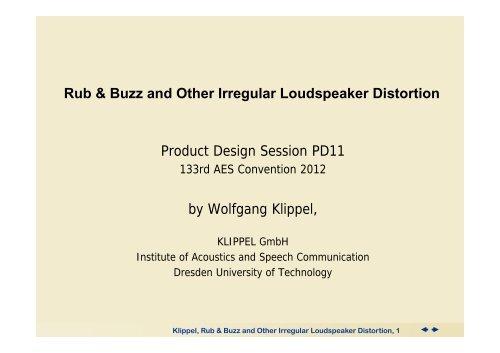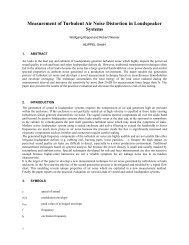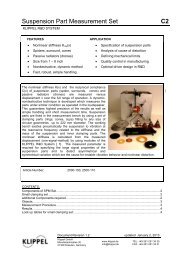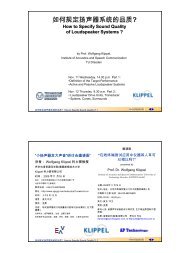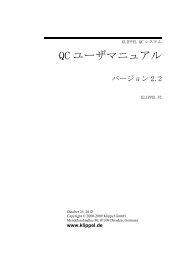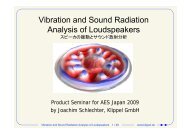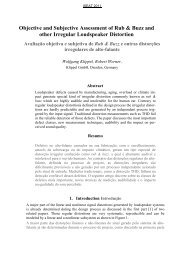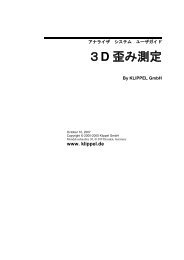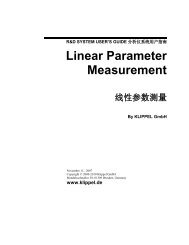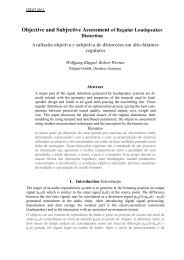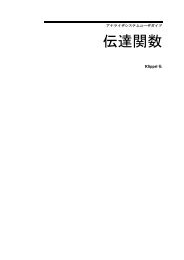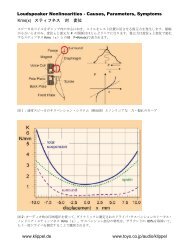Rub & Buzz and Other Irregular Loudspeaker ... - Klippel GmbH
Rub & Buzz and Other Irregular Loudspeaker ... - Klippel GmbH
Rub & Buzz and Other Irregular Loudspeaker ... - Klippel GmbH
You also want an ePaper? Increase the reach of your titles
YUMPU automatically turns print PDFs into web optimized ePapers that Google loves.
<strong>Rub</strong> & <strong>Buzz</strong> <strong>and</strong> <strong>Other</strong> <strong>Irregular</strong> <strong>Loudspeaker</strong> Distortion<br />
Product Design Session PD11<br />
133rd AES Convention 2012<br />
by Wolfgang <strong>Klippel</strong>,<br />
KLIPPEL <strong>GmbH</strong><br />
Institute of Acoustics <strong>and</strong> Speech Communication<br />
Dresden University of Technology<br />
<strong>Klippel</strong>, <strong>Rub</strong> & <strong>Buzz</strong> <strong>and</strong> <strong>Other</strong> <strong>Irregular</strong> <strong>Loudspeaker</strong> Distortion, 1
Abstract<br />
<strong>Loudspeaker</strong> defects caused by manufacturing, aging, overload or climate<br />
impact generate special kind of irregular distortion commonly known as<br />
rub & buzz which are highly audible <strong>and</strong> intolerable for the human ear.<br />
Contrary to regular loudspeaker distortions defined in the design process<br />
the irregular distortions are hardly predictable <strong>and</strong> are generated by an<br />
independent process triggered by the input signal. Traditional distortion<br />
measurements such as THD fail in the reliable detection of those defects.<br />
The Tutorial discusses the most important defect classes, new<br />
measurement techniques, audibility <strong>and</strong> the impact on perceived sound<br />
quality.<br />
<strong>Klippel</strong>, <strong>Rub</strong> & <strong>Buzz</strong> <strong>and</strong> <strong>Other</strong> <strong>Irregular</strong> <strong>Loudspeaker</strong> Distortion, 2
Problems addressed here:<br />
• What is <strong>Rub</strong> & <strong>Buzz</strong> ?<br />
• What kinds of symptoms are generated by irregular<br />
loudspeaker defects ?<br />
• Why do straightforward measurements fail in<br />
detecting those defects ?<br />
• Do we need a measurement more sensitive than the<br />
human ear ?<br />
• How to cope with ambient production noise ?<br />
• How to find the root cause <strong>and</strong> how to fix the<br />
problem ?<br />
<strong>Klippel</strong>, <strong>Rub</strong> & <strong>Buzz</strong> <strong>and</strong> <strong>Other</strong> <strong>Irregular</strong> <strong>Loudspeaker</strong> Distortion, 3
Desired <strong>and</strong> Undesired Components ?<br />
Generation of Signal Distortion in an Audio System<br />
Input<br />
Signal<br />
Desired Small<br />
Signal Performance<br />
Desired Large<br />
Signal Performance<br />
Stimulus<br />
Linear Model<br />
Nonlinear<br />
Model<br />
Unpredictable<br />
Dynamics<br />
Regular linear<br />
distortion<br />
Regular nonlinear<br />
distortion<br />
Undesired <strong>Loudspeaker</strong> Defects<br />
• <strong>Rub</strong>bing coils , buzzing parts<br />
• Wire beat, coil bottoming<br />
• Loose particles, air leak noise<br />
• Parasitic vibration of other components<br />
Excessive nonlinear<br />
distortion<br />
Measured<br />
Signal<br />
Noise<br />
<strong>Klippel</strong>, Sound Quality of Audio Systems, Part 1 Introduction , 4<br />
Output<br />
Signal
<strong>Loudspeaker</strong> Defect: <strong>Buzz</strong> problem<br />
Most defects behave as a nonlinear oscillator<br />
• active above a critical amplitude<br />
• new mode of vibration<br />
• powered <strong>and</strong> synchronized by stimulus<br />
• constant output power<br />
vibration<br />
distortion signal<br />
parasitic resonator<br />
one period<br />
Externally excited<br />
mass<br />
spring<br />
<strong>Klippel</strong>, Sound Quality of Audio Systems, Diagnostics on <strong>Irregular</strong> <strong>Loudspeaker</strong> Defects, 5<br />
Loose joint<br />
(Nonlinearity)<br />
time
<strong>Loudspeaker</strong> Defect: Voice Coil Bottoming<br />
Voice coil Voice coil<br />
Voice coil<br />
backplate backplate backplate backplate<br />
distortion signal<br />
Short impulse, deterministic symptom<br />
one period<br />
Voice coil<br />
<strong>Klippel</strong>, Sound Quality of Audio Systems, Diagnostics on <strong>Irregular</strong> <strong>Loudspeaker</strong> Defects, 6<br />
time
<strong>Loudspeaker</strong> Defect: Voice Coil <strong>Rub</strong>bing<br />
• signal contains reproducible <strong>and</strong><br />
stochastic components<br />
gap<br />
Voice coil<br />
voice coil rubbing<br />
distortion signal<br />
Cause: rocking mode at 328 Hz<br />
one period<br />
<strong>Klippel</strong>, Sound Quality of Audio Systems, Diagnostics on <strong>Irregular</strong> <strong>Loudspeaker</strong> Defects, 7<br />
time
<strong>Loudspeaker</strong> Defect: Air Noise<br />
• stochastic signal<br />
• air pressure is changed by coil displacement<br />
• synchronized with stimulus – signal envelope<br />
one period<br />
Air noise<br />
<strong>Klippel</strong>, Sound Quality of Audio Systems, Diagnostics on <strong>Irregular</strong> <strong>Loudspeaker</strong> Defects, 8<br />
gap<br />
cone<br />
leakage<br />
dust cap<br />
time
<strong>Loudspeaker</strong> Defect: Loose Particles<br />
• r<strong>and</strong>om process<br />
• impulsive<br />
• particles are accelerated by cone displacement<br />
• not synchronized with stimulus<br />
• constant output power<br />
bouncing<br />
distortion signal<br />
bouncing<br />
one period<br />
Voice<br />
coil<br />
former<br />
<strong>Klippel</strong>, Sound Quality of Audio Systems, Diagnostics on <strong>Irregular</strong> <strong>Loudspeaker</strong> Defects, 9<br />
gap<br />
cone<br />
dust cap<br />
Loose Particle<br />
time
Audibility <strong>and</strong> Impact on Sound Quality<br />
<strong>Klippel</strong>, Sound Quality of Audio Systems, Diagnostics on <strong>Irregular</strong> <strong>Loudspeaker</strong> Defects, 10
Searching for a Critical Stimulus<br />
Audibility of Voice Coil <strong>Rub</strong>bing<br />
Signal Stimulus Output<br />
1V<br />
Music<br />
Multi-Tone<br />
20 Hz – 20 kHz<br />
Multi-Tone<br />
20 Hz – 1 kHz<br />
Sinussoidal Sweep<br />
1 s<br />
Most sensitive Stimulus<br />
Output<br />
2V<br />
Output<br />
3V<br />
<strong>Klippel</strong>, Sound Quality of Audio Systems, Diagnostics on <strong>Irregular</strong> <strong>Loudspeaker</strong> Defects, 11
Masking of <strong>Loudspeaker</strong> Defects<br />
Masking Threshold<br />
Hearing Threshold<br />
Passed Failed<br />
Air Leak<br />
• irregular distortion produce high frequency components<br />
• no masking from fundamental component at low frequencies<br />
• close to the hearing threshold<br />
<strong>Klippel</strong>, <strong>Rub</strong> & <strong>Buzz</strong> <strong>and</strong> <strong>Other</strong> <strong>Irregular</strong> <strong>Loudspeaker</strong> Distortion, 12
Impact on Sound Quality<br />
Amplitude modulation<br />
(Envelope modulated by the bass signal 20…300 Hz)<br />
Spectrogram <strong>and</strong> time signal of leak noise<br />
time<br />
High-Frequency components<br />
(Increasing spectral power above 3 kHz)<br />
Increased Roughness Increased Sharpness<br />
Sensation: aggressive, unnatural, more noticeable<br />
Degradation of<br />
Sound Quality<br />
Signal spectrum of an intact <strong>and</strong> a defective speaker<br />
<strong>Klippel</strong>, <strong>Rub</strong> & <strong>Buzz</strong> <strong>and</strong> <strong>Other</strong> <strong>Irregular</strong> <strong>Loudspeaker</strong> Distortion, 13<br />
frequency
Auralization of <strong>Irregular</strong> Distortion (<strong>Rub</strong> & buzz)<br />
Example 1 : Headphone, sinusoidal sweep as stimulus<br />
35<br />
Distortion to 30 Mask Ratio = 45dB<br />
dB<br />
55<br />
50<br />
45<br />
40<br />
35<br />
Distortion to Mask 30 Ratio = 22dB<br />
dB<br />
55<br />
50<br />
45<br />
40<br />
Perceptual Attributes:<br />
Change of Sharpness 25 = 130 %<br />
Discolouration 20 =130 %<br />
Modulation = 1200<br />
15<br />
10<br />
Perceptual Attributes:<br />
5<br />
Change of Sharpness 25 = 27%<br />
Discolouration 20=16<br />
%<br />
Modulation = 1000<br />
15<br />
10<br />
5<br />
Distortion (Ref) Masking pattern Internal noise<br />
102 103 104 f in Hz<br />
Distortion (Ref) Masking pattern Internal noise<br />
102 103 104 f in Hz<br />
KLIPPEL<br />
S Dis =0dB<br />
KLIPPEL<br />
S Dis =-24dB<br />
20<br />
Discolouration =50 %<br />
15<br />
Modulation = 1200<br />
10<br />
<strong>Klippel</strong>, <strong>Rub</strong> & <strong>Buzz</strong> <strong>and</strong> <strong>Other</strong> <strong>Irregular</strong> <strong>Loudspeaker</strong> Distortion, 14<br />
dB<br />
dB<br />
55<br />
50<br />
45<br />
40<br />
35<br />
10<br />
5<br />
55<br />
50<br />
45<br />
40<br />
35<br />
Perceptiual Attributes:<br />
30<br />
Distortion to Mask Ratio = 32dB<br />
25<br />
Change of Sharpness = 55 %<br />
5<br />
Distortion (Ref) Masking pattern Internal noise<br />
102 103 104 f in Hz<br />
Perceptual Attributes:<br />
30<br />
Distortion to Mask Ratio = 7dB<br />
25<br />
Change of Sharpness = 7 %<br />
20<br />
Discolouration =4 %<br />
15<br />
Modulation = 700<br />
Distortion (Ref) Masking pattern Internal noise<br />
102 103 104 f in Hz<br />
KLIPPEL<br />
S Dis =-12dB<br />
KLIPPEL<br />
S Dis =-36dB
Example 2: Automotive Audio System<br />
organ music in woofer channel, <strong>Irregular</strong> distortion<br />
Door <strong>Buzz</strong>ing<br />
End-of-line testing Off-line<br />
Processing<br />
Test with sweep for loudspeaker<br />
defects <strong>and</strong> parasitic vibration<br />
Recording of reproduced music<br />
stimulus if defect is detected<br />
reference<br />
Engineering<br />
S DIS = 24 dB S DIS = 12 dB S DIS = -6 dB<br />
S DIS = 0 dB<br />
Measurement<br />
results<br />
recorded<br />
wave-file<br />
Auralization +<br />
Perceptive<br />
Evaluation<br />
<strong>Klippel</strong>, Sound Quality of Audio Systems, Part 13 Specification in R&D <strong>and</strong> QC, 15<br />
S DIS = -12 dB<br />
Marketing<br />
Management
ated sound quality<br />
10 = „high“<br />
0 = „low“<br />
Sensations of <strong>Irregular</strong> Nonlinearities<br />
while increasing the distortion signal<br />
audibilty<br />
100%<br />
75%<br />
„improves bass<br />
sensation“<br />
audibilty<br />
threshold<br />
<strong>Klippel</strong>, <strong>Rub</strong> & <strong>Buzz</strong> <strong>and</strong> <strong>Other</strong> <strong>Irregular</strong> <strong>Loudspeaker</strong> Distortion, 16<br />
psychometric<br />
function of<br />
audibility<br />
5 = „medium“ 50%<br />
Kms(x)<br />
distortion<br />
voice coil rubbing<br />
distortion ratio
Engineering<br />
Subjective <strong>and</strong> Objective Evaluation<br />
in <strong>Loudspeaker</strong> Development<br />
Objective<br />
Evaluation<br />
Physical Data<br />
• Distortion, Maximal Output<br />
• Displacement, Temperature<br />
• Evaluation of Design Choices<br />
• Clues for Improvements<br />
Listening Test + Auralization<br />
Perceptive Modeling<br />
Performance/cost ratio<br />
Subjective<br />
Evaluation<br />
S DIS<br />
Audibility of distortion<br />
Perference,<br />
<strong>Klippel</strong>, <strong>Rub</strong> & <strong>Buzz</strong> <strong>and</strong> <strong>Other</strong> <strong>Irregular</strong> <strong>Loudspeaker</strong> Distortion, 17<br />
Marketing<br />
Management<br />
• Defining target specification<br />
• Tuning to the market
Are loudspeaker defects are acceptable<br />
which are inaudible for a human ear in a<br />
production environment ?<br />
NO !<br />
• some loudspeaker defects become worse over time<br />
(after break-in of the suspension)<br />
• some loudspeaker defects generate r<strong>and</strong>om symptoms<br />
(loose particles)<br />
• the production noise masks the symptoms of the defect<br />
(air leakage)<br />
• the end user may use a more critical stimulus (low<br />
frequency bass)<br />
• Significant loss of sound quality if symptoms detected by<br />
customer<br />
<strong>Klippel</strong>, <strong>Rub</strong> & <strong>Buzz</strong> <strong>and</strong> <strong>Other</strong> <strong>Irregular</strong> <strong>Loudspeaker</strong> Distortion, 18
Consequences of Subjective Testing at<br />
the Assembling Line<br />
• Need for trained operators more sensitive than the end<br />
user<br />
• Avoiding fatigue of the human ears (regular breaks, low<br />
SPL)<br />
• Operating the loudspeaker under similar condition as in<br />
the final application (listening distance, amplitude, load)<br />
• Sufficient time for human inspection (flexible <strong>and</strong> long<br />
cycle times)<br />
Human testing is expensive, not reliable <strong>and</strong> highly subjective !<br />
<strong>Klippel</strong>, <strong>Rub</strong> & <strong>Buzz</strong> <strong>and</strong> <strong>Other</strong> <strong>Irregular</strong> <strong>Loudspeaker</strong> Distortion, 19
Need for Objective Measurements<br />
which<br />
• are faster<br />
• can be integrated in an automated line<br />
• give reproducible, reliable results<br />
• are more sensitive than the human ear<br />
• are comparable with R&D, target performance<br />
• are immune against ambient noise<br />
• show the root cause of the defect<br />
• are the basis for process control<br />
<strong>Klippel</strong>, <strong>Rub</strong> & <strong>Buzz</strong> <strong>and</strong> <strong>Other</strong> <strong>Irregular</strong> <strong>Loudspeaker</strong> Distortion, 20
Generation<br />
of Stimulus<br />
Basic Requirements to detect<br />
<strong>Irregular</strong> <strong>Loudspeaker</strong> Defects<br />
Measurement of<br />
State Variables<br />
Analysis<br />
Symptoms<br />
• High displacement x <strong>and</strong>/or velocity v is required<br />
Stimulus with sufficient low frequency content<br />
• Defects produce only acoustical symptoms<br />
Sensitive microphone required<br />
• Defects produce high frequency components<br />
Low-pass filtered stimulus <strong>and</strong> high-pass filtered microphone<br />
signal<br />
• Defects are similar to ambient noise<br />
Microphone is located close to the source (near-field<br />
measurement)<br />
<strong>Klippel</strong>, <strong>Rub</strong> & <strong>Buzz</strong> <strong>and</strong> <strong>Other</strong> <strong>Irregular</strong> <strong>Loudspeaker</strong> Distortion, 21
[V]<br />
5,0<br />
2,5<br />
0,0<br />
-2,5<br />
-5,0<br />
Optimal Stimulus<br />
Stimulus (t)<br />
Excitation of <strong>Irregular</strong> <strong>Loudspeaker</strong> Defect<br />
Stimulus (t) vs time<br />
0 100 200 300 400 500<br />
Time [ms]<br />
600 700 800 900 1000<br />
Continous sweep with<br />
speed profile<br />
Why using continuous sweep?<br />
• Defects may be resonators with high Q-factor<br />
• Missed, if not excited exactly<br />
• Critical: Stepped excitation with low resolution<br />
<strong>Klippel</strong>, <strong>Rub</strong> & <strong>Buzz</strong> <strong>and</strong> <strong>Other</strong> <strong>Irregular</strong> <strong>Loudspeaker</strong> Distortion, 22<br />
0,2<br />
0,1<br />
0,0<br />
-0,1<br />
-0,2<br />
-0,3<br />
[V]<br />
0,50<br />
0,25<br />
-0,00<br />
-0,25<br />
-0,50<br />
Y1 (t)<br />
Response<br />
0 500 1000 1500<br />
Time [ms]<br />
2000 2500<br />
Fund. Buffer<br />
Response Detail<br />
6*101 8*101 102 2*102 Frequency [Hz]<br />
Defect
Stimulus:<br />
Sound Pressure [dB]<br />
120<br />
110<br />
100<br />
90<br />
80<br />
70<br />
60<br />
50<br />
40<br />
30<br />
20<br />
10<br />
Voice Coil <strong>Rub</strong>bing<br />
multi-tone complex 20 Hz – 20 kHz<br />
Noise Floor<br />
Fundamental 3V<br />
Multitone Distortion<br />
KLIPPEL<br />
10 2 10 3 10 4<br />
Frequency [Hz]<br />
Regular distortion masked higher-order harmonics<br />
Multi-tone distortion is not sensitive for coil rubbing <strong>and</strong> other defects<br />
<strong>Klippel</strong>, <strong>Rub</strong> & <strong>Buzz</strong> <strong>and</strong> <strong>Other</strong> <strong>Irregular</strong> <strong>Loudspeaker</strong> Distortion, 23<br />
2V<br />
1V<br />
3V
Voice Coil <strong>Rub</strong>bing<br />
Measurement of Incoherence with a music stimulus<br />
Percent<br />
100<br />
10<br />
1<br />
Defect speaker<br />
Good speaker<br />
KLIPPEL<br />
10 2 10 3 10 4<br />
Frequency [Hz]<br />
Distortion from regular nonlinearities mask symptoms from rub <strong>and</strong> buzz<br />
Incoherence measurement is not sensitive for impulsive distortion<br />
<strong>Klippel</strong>, Sound Quality of Audio Systems, Diagnostics on <strong>Irregular</strong> <strong>Loudspeaker</strong> Defects, 24
Sound Pressure [dB]<br />
130<br />
120<br />
110<br />
100<br />
90<br />
80<br />
70<br />
60<br />
Sound Pressure [dB]<br />
Sound Pressure [dB]<br />
130<br />
120<br />
110<br />
100<br />
90<br />
80<br />
70<br />
60<br />
50<br />
140<br />
130<br />
120<br />
110<br />
100<br />
90<br />
80<br />
70<br />
60<br />
Frequency Response<br />
2<br />
10<br />
THD Max<br />
Frequency Response<br />
THD Max<br />
3<br />
10<br />
Frequency [Hz]<br />
THD<br />
THD<br />
Voice Coil <strong>Rub</strong>bing<br />
Stimulus: sinusoidal sweep<br />
KLIPPEL<br />
210 310 Frequency [Hz]<br />
410<br />
KLIPPEL<br />
4<br />
10<br />
1V<br />
2V<br />
Frequency Response<br />
THD Max<br />
100 1000 10000<br />
Frequency [Hz]<br />
•THD measures the rms value<br />
of all harmonics<br />
•Regular distortion are<br />
dominant<br />
•Distortion of defects have not<br />
much energy<br />
THD is not sensitive for coil<br />
rubbing <strong>and</strong> other irregular<br />
defects !!<br />
THD<br />
KLIPPEL<br />
<strong>Klippel</strong>, Sound Quality of Audio Systems, Diagnostics on <strong>Irregular</strong> <strong>Loudspeaker</strong> Defects, 25<br />
3V
Sound Pressure Level of Signal Components<br />
Voltage at<br />
Terminals<br />
Input<br />
Signal<br />
Measured<br />
Signal<br />
130 dB<br />
Linear System SPL at Mic<br />
Regular<br />
Harmonics<br />
<strong>Irregular</strong><br />
Harmonics<br />
(Defects)<br />
90 dB<br />
50 dB<br />
Noise<br />
40 - 60 dB<br />
<strong>Klippel</strong>, <strong>Rub</strong> & <strong>Buzz</strong> <strong>and</strong> <strong>Other</strong> <strong>Irregular</strong> <strong>Loudspeaker</strong> Distortion, 26
Symptoms of a <strong>Loudspeaker</strong> Defect<br />
loudspeaker with <strong>and</strong> without rubbing coil<br />
- 80 dB<br />
Masked by<br />
noise <strong>and</strong><br />
regular<br />
distortion<br />
IN1 [V] (rms)<br />
10-1<br />
10-2<br />
10-3<br />
10-4<br />
10<br />
-5<br />
10-6<br />
10-7<br />
with failure without failure Fundamental<br />
KLIPPEL<br />
-0 500 1000 1500<br />
Frequency [Hz]<br />
2000 2500 3000<br />
Fundamental<br />
50 Hz<br />
Regular<br />
nonlinear<br />
distortion<br />
<strong>Loudspeaker</strong><br />
Defect<br />
<strong>Klippel</strong>, <strong>Rub</strong> & <strong>Buzz</strong> <strong>and</strong> <strong>Other</strong> <strong>Irregular</strong> <strong>Loudspeaker</strong> Distortion, 27
Frequency Domain Analysis<br />
60 Hz Tone reproduced by a good <strong>and</strong> bad speaker<br />
fundamental<br />
High Pass Filtering<br />
2nd 3rd<br />
required to suppress<br />
fundamental <strong>and</strong> low order<br />
harmonics<br />
ambient noise<br />
Failed<br />
Passed<br />
<strong>Klippel</strong>, <strong>Rub</strong> & <strong>Buzz</strong> <strong>and</strong> <strong>Other</strong> <strong>Irregular</strong> <strong>Loudspeaker</strong> Distortion, 28
Simple Approach<br />
exploiting amplitude of higher-order harmonics only<br />
SPL<br />
fundam ental<br />
Regular<br />
distortion higher order<br />
harmonics<br />
RMS value of<br />
Higherharmonics<br />
amplitude<br />
spectrum<br />
frequency<br />
PROBLEMS:<br />
• considering deterministic defects only<br />
• each harmonic is close to the noise level<br />
• insensitive to loose particles <strong>and</strong> air leakage noise<br />
<strong>Klippel</strong>, <strong>Rub</strong> & <strong>Buzz</strong> <strong>and</strong> <strong>Other</strong> <strong>Irregular</strong> <strong>Loudspeaker</strong> Distortion, 29
SPL<br />
SPL<br />
360<br />
180<br />
0<br />
RMS value<br />
(MHD)<br />
fundamental<br />
fundamental<br />
Time Domain Analysis<br />
Regular<br />
Regular<br />
distortion<br />
distortion higher order<br />
harmonics<br />
FFT -1<br />
peak-value<br />
rms-value<br />
Crest factor<br />
amplitude<br />
spectrum<br />
frequency<br />
phase<br />
spectrum<br />
time<br />
Peak value<br />
(PHD)<br />
Solution back to the time domain<br />
exploiting amplitude <strong>and</strong> phase of<br />
higher-harmonics <strong>and</strong> all non-harmonic<br />
components<br />
peak value reveals small transients<br />
(clicks)<br />
Sensitive for all loudspeaker defects<br />
most loudspeaker defects generate symptoms with<br />
high crest factor<br />
but<br />
regular loudspeaker distortions, electrical <strong>and</strong><br />
microphone noise have lower crest factor<br />
<strong>Klippel</strong>, <strong>Rub</strong> & <strong>Buzz</strong> <strong>and</strong> <strong>Other</strong> <strong>Irregular</strong> <strong>Loudspeaker</strong> Distortion, 30
Single tone with varying<br />
frequency f (chirp)<br />
Sinusoidal<br />
Generator<br />
~<br />
Sound Pressure [dB]<br />
Peak value Contra rms-Value<br />
Amplifier<br />
Drive<br />
Unit<br />
Microphone<br />
instantaneous frequency f<br />
130<br />
120<br />
110<br />
100<br />
90<br />
80<br />
70<br />
60<br />
peak value (PHD)<br />
rms value (MHD)<br />
Frequency Response<br />
High-pass<br />
cut-off frequency fc > 10f<br />
Tracking<br />
Filter<br />
100 1000<br />
Frequency [Hz]<br />
10000<br />
squarer<br />
integrator<br />
peak<br />
detector<br />
High-pass filtered<br />
Distortion<br />
rms value<br />
(MHD)<br />
peak value<br />
(PHD)<br />
Peak value (PHD) is a sensitive<br />
measure for most irregular defects<br />
such as „rub <strong>and</strong> buzz“, loose<br />
particles !!<br />
<strong>Klippel</strong>, <strong>Rub</strong> & <strong>Buzz</strong> <strong>and</strong> <strong>Other</strong> <strong>Irregular</strong> <strong>Loudspeaker</strong> Distortion, 31
[V]<br />
0,03<br />
0,02<br />
0,01<br />
0,00<br />
-0,01<br />
-0,02<br />
-0,03<br />
Distortion Signal in the Time Domain<br />
output of the high-pass filter f c=20f<br />
ZOOM<br />
Total sound pressure<br />
50<br />
Model error<br />
distortion signal<br />
Period<br />
Frequency [Hz]<br />
• Regular distortion have high energy<br />
• Disturbances have low energy<br />
• Disturbances are concentrated in time during a period<br />
impulsive distortion (high crest factor)<br />
Active compensation is useful<br />
<strong>Klippel</strong>, <strong>Rub</strong> & <strong>Buzz</strong> <strong>and</strong> <strong>Other</strong> <strong>Irregular</strong> <strong>Loudspeaker</strong> Distortion, 32<br />
KLIPPEL
Sound Pressure [dB]<br />
130<br />
120<br />
110<br />
100<br />
90<br />
80<br />
70<br />
60<br />
50<br />
3V<br />
Frequency Response Response Max Response Min THD<br />
THD Max <strong>Rub</strong>+<strong>Buzz</strong> <strong>Rub</strong>+<strong>Buzz</strong> Max<br />
2<br />
10<br />
Sound Pressure [dB]<br />
140<br />
130<br />
120<br />
110<br />
100<br />
90<br />
80<br />
70<br />
60<br />
3<br />
10<br />
Frequency [Hz]<br />
KLIPPEL<br />
4<br />
10<br />
PHD<br />
Voice Coil <strong>Rub</strong>bing<br />
Stimulus: sinusoidal sweep<br />
1V<br />
PHD Max<br />
Sound Pressure [dB]<br />
130<br />
120<br />
110<br />
100<br />
90<br />
80<br />
70<br />
60<br />
Frequency Response Response Max Response Min THD<br />
THD Max <strong>Rub</strong>+<strong>Buzz</strong> <strong>Rub</strong>+<strong>Buzz</strong> Max<br />
Frequency Response<br />
KLIPPEL<br />
102 103 104 Frequency [Hz]<br />
<strong>Klippel</strong>, <strong>Rub</strong> & <strong>Buzz</strong> <strong>and</strong> <strong>Other</strong> <strong>Irregular</strong> <strong>Loudspeaker</strong> Distortion, 33<br />
KLIPPEL<br />
210 310 410<br />
Frequency [Hz]<br />
2V<br />
Peak value of highpass<br />
filtered<br />
distortion exceeds<br />
limit by 40 dB !!
Sinusoidal<br />
Stimulus<br />
Defect: Loose Particle<br />
Sound Pressure [dB]<br />
130<br />
120<br />
110<br />
100<br />
90<br />
80<br />
70<br />
60<br />
PHD<br />
Peak Value of high-pass<br />
50<br />
filtered distortion<br />
exceeds limit by 40 dB<br />
!!<br />
Frequency Response<br />
PHD Max<br />
Response Max<br />
Response Min<br />
THD<br />
THD Max<br />
<strong>Klippel</strong>, <strong>Rub</strong> & <strong>Buzz</strong> <strong>and</strong> <strong>Other</strong> <strong>Irregular</strong> <strong>Loudspeaker</strong> Distortion, 34<br />
KLIPPEL<br />
102 103 104 Frequency [Hz]
Sinusoidal<br />
Stimulus<br />
Very Small Loose Particle<br />
Sound Pressure [dB]<br />
130<br />
120<br />
110<br />
100<br />
90<br />
80<br />
70<br />
60<br />
Peak Value of high-pass<br />
filtered distortion50 exceeds<br />
limit by 10 dB !!<br />
one grain of fine salt<br />
PHD Max<br />
Response Max<br />
Response Min<br />
PHD<br />
Frequency Response<br />
THD Max<br />
<strong>Klippel</strong>, <strong>Rub</strong> & <strong>Buzz</strong> <strong>and</strong> <strong>Other</strong> <strong>Irregular</strong> <strong>Loudspeaker</strong> Distortion, 35<br />
KLIPPEL<br />
102 103 104 Frequency [Hz]<br />
MHD
Crest factor of high-pass filtered distortion (CHD)<br />
Stimulus: Sinusoidal sweep<br />
[dB]<br />
20,0<br />
17,5<br />
15,0<br />
12,5<br />
10,0<br />
7,5<br />
5,0<br />
2,5<br />
CHD<br />
CHD ( f ) <br />
rub & buzz, other disturbances<br />
50 100 200 500<br />
Frequency [Hz]<br />
PHD<br />
MHD<br />
peak-value within one period<br />
Rms-value averaged over one period<br />
regular distortion<br />
KLIPPEL<br />
CHD can be interpreted on an absolute scale !<br />
CHD expoits the phase information of all high frequency components<br />
<strong>Klippel</strong>, <strong>Rub</strong> & <strong>Buzz</strong> <strong>and</strong> <strong>Other</strong> <strong>Irregular</strong> <strong>Loudspeaker</strong> Distortion, 36<br />
12 dB
ICHD<br />
Instantaneous crest factor of<br />
high-pass filtered distortion ICHD(f,x)<br />
good 12 dB bad<br />
Frequency of sine sweep<br />
time<br />
<strong>Klippel</strong>, <strong>Rub</strong> & <strong>Buzz</strong> <strong>and</strong> <strong>Other</strong> <strong>Irregular</strong> <strong>Loudspeaker</strong> Distortion, 37
<strong>Loudspeaker</strong> Defect or Noise ?<br />
dB<br />
130<br />
120<br />
110<br />
100<br />
90<br />
80<br />
70<br />
60<br />
50<br />
40<br />
Fund. mean<br />
3rd<br />
THD<br />
2nd<br />
PHD<br />
CHD<br />
MHD<br />
Fundamental<br />
PHD limit<br />
(-40dB)<br />
10 20 50 100 200 500 1k 2k 5k 10k<br />
Frequency [Hz]<br />
Symptoms of a significant defect:<br />
1. Sufficient amplitude: peak value PHD > FUND mean - 40dB<br />
2. Impulsive: crest factor CHD > 12dB<br />
Check for coincidence !<br />
(microphone noise is not<br />
impulsive)<br />
<strong>Klippel</strong>, <strong>Rub</strong> & <strong>Buzz</strong> <strong>and</strong> <strong>Other</strong> <strong>Irregular</strong> <strong>Loudspeaker</strong> Distortion, 38<br />
is not an<br />
audibility<br />
threshold<br />
!
Characteristics for Diagnostics<br />
Single-valued parameter derived from PHD <strong>and</strong> CHD<br />
Batch of TRF measurements<br />
6V<br />
8V<br />
10V<br />
12V<br />
voltage<br />
dB dB - - [V] [V] (rms)<br />
(rms)<br />
Fundamental Fundamental + + Harmonic Harmonic distortion distortion components components (SHAPED (SHAPED STIMULUS)<br />
STIMULUS)<br />
130<br />
130<br />
120<br />
120<br />
120<br />
110<br />
110<br />
110<br />
100<br />
100<br />
100<br />
90<br />
90<br />
90<br />
80<br />
80<br />
80 80<br />
70<br />
70<br />
70 70<br />
60 60<br />
60 60<br />
50 50<br />
CHD > 12dB<br />
impulsive<br />
Signal Signal<br />
Signal at at<br />
IN1<br />
IN1<br />
Fundamental Fundamental<br />
Fundamental THD THD<br />
THD 2nd<br />
2nd<br />
2nd Harmonic Harmonic<br />
Harmonic 3rd 3rd<br />
Harmonic<br />
Harmonic<br />
Absolute Absolute<br />
Absolute PHD<br />
PHD<br />
PHD Fund. Fund.<br />
Fund. mean<br />
mean<br />
mean (100<br />
(100<br />
(100 to to<br />
to 500 500<br />
500 Hz) Hz)<br />
PHD PHD<br />
limit limit<br />
(-40dB)<br />
(-40dB)<br />
f r&b<br />
-40 dB<br />
KLIPPEL KLIPPEL<br />
50 40<br />
50 40<br />
10 10 20 20 50 50 100 100 200 200 500 500 500<br />
1k 1k<br />
2k 2k 2k<br />
5k 5k 5k<br />
10k 10k<br />
10k<br />
Frequency Frequency<br />
Frequency [Hz] [Hz]<br />
[Hz]<br />
Significant<br />
defect (R&B)<br />
PHD > FUNDmean - 40dB<br />
high amplitude<br />
12V<br />
Conditions:<br />
Rms Voltage U r&b = 12 V<br />
Peak displacement X r&b= 4mm<br />
Frequency f r&b = 65 Hz<br />
Inst. Displacement x in, r&b = 3.8 mm<br />
<strong>Klippel</strong>, <strong>Rub</strong> & <strong>Buzz</strong> <strong>and</strong> <strong>Other</strong> <strong>Irregular</strong> <strong>Loudspeaker</strong> Distortion, 39
Diagnostics on <strong>Irregular</strong> Defect (1 st example)<br />
Conditions:<br />
• Positive peak displacement at 0.5 mm below f s<br />
• above a terminal voltage of 0.9 V<br />
Root Cause: Bottoming<br />
<strong>Klippel</strong>, <strong>Rub</strong> & <strong>Buzz</strong> <strong>and</strong> <strong>Other</strong> <strong>Irregular</strong> <strong>Loudspeaker</strong> Distortion, 40
Diagnostics on <strong>Irregular</strong> Defect (2 nd example)<br />
Conditions:<br />
• Negative turning point of voice coil excursion above f s<br />
• maximal acceleration Tilting of voice coil former<br />
• independent of displacement<br />
Root Cause: Voice coil <strong>Rub</strong>bing<br />
<strong>Klippel</strong>, <strong>Rub</strong> & <strong>Buzz</strong> <strong>and</strong> <strong>Other</strong> <strong>Irregular</strong> <strong>Loudspeaker</strong> Distortion, 41
Clues for Diagnostics of Defects<br />
derived from ICHD(f,u) measured versus frequency f <strong>and</strong> voltage u<br />
• Coil rubbing initiated by a tilting of the voice coil former occurs at maximal acceleration<br />
corresponding with the positive <strong>and</strong> negative maxima of the displacement. This occurs<br />
usually at frequencies above resonance where the acceleration is maximal while the<br />
amplitude of the displacement decreases. When the voltage is increased the coil rubbing will<br />
also occur at the turning points of the voice coil at higher displacement values.<br />
• <strong>Buzz</strong>ing part generates high ICHD for particular (reproducible) values of frequencies <strong>and</strong><br />
displacement because it behaves like a coupled nonlinear resonator. Above a critical voltage<br />
when it starts this defect is almost independent on the peak displacement.<br />
• Coil bottoming at the rear plate generates high ICHD at a clearly defined negative<br />
displacement independent of frequency. Increasing the voltage of the excitation the maximal<br />
negative displacement is constant but the loudspeaker generates a dc displacement shifting<br />
the coil in the opposite direction.<br />
• Limiting surround generates high ICHD at maximal positive or negative displacement<br />
independent of the excitation frequency. The instantaneous displacement where ICHD > 12<br />
dB raises by increasing the voltage because the suspension behaves not as a hard limiting<br />
nonlinearity like coil bottoming.<br />
• Tensile slap generates a high value of ICHD at reproducible values of displacement <strong>and</strong><br />
frequency because the wire behaves as a coupled mechanical system having its own<br />
vibration mode <strong>and</strong> natural frequency.<br />
• Air leakage in a dust cap generates a high ICHD for frequencies below resonance f< fs<br />
where the sound pressure of the enclosed air is high.<br />
• Loose particles generate ICHD > 12 dB at r<strong>and</strong>om values of frequencies <strong>and</strong> instantaneous<br />
displacement.<br />
<strong>Klippel</strong>, <strong>Rub</strong> & <strong>Buzz</strong> <strong>and</strong> <strong>Other</strong> <strong>Irregular</strong> <strong>Loudspeaker</strong> Distortion, 42
Basic Classification of <strong>Loudspeaker</strong> Defects<br />
Coil hitting<br />
backplate<br />
Waveform is<br />
completely<br />
reproducible<br />
<strong>Buzz</strong>ing loose<br />
joint<br />
vibration<br />
<strong>Rub</strong>bing<br />
voice coil<br />
Envelope is<br />
reproducible<br />
(Waveform is not)<br />
Flow noise at air<br />
leak<br />
Loose particle<br />
hitting<br />
membrane<br />
Semi‐r<strong>and</strong>om<br />
Deterministic R<strong>and</strong>om<br />
(mixed characteristic)<br />
Waveform is not<br />
reproducible<br />
<strong>Klippel</strong>, <strong>Rub</strong> & <strong>Buzz</strong> <strong>and</strong> <strong>Other</strong> <strong>Irregular</strong> <strong>Loudspeaker</strong> Distortion, 43<br />
Loose particle
Exploiting all Symptoms of the Defect<br />
SPL<br />
fundamental<br />
2nd<br />
3rd<br />
Regular<br />
distortion<br />
4th<br />
High-pass filtered<br />
symptoms <strong>and</strong> noise<br />
SPL<br />
f<br />
Symptoms of<br />
defects<br />
noise level<br />
frequency<br />
High-pass Filter<br />
cut-off frequency f c > 10f<br />
SPL<br />
Comb Filter<br />
Order n > 10th<br />
frequency<br />
Deterministic part<br />
(higher-order harmonics)<br />
<strong>Klippel</strong>, <strong>Rub</strong> & <strong>Buzz</strong> <strong>and</strong> <strong>Other</strong> <strong>Irregular</strong> <strong>Loudspeaker</strong> Distortion, 44<br />
SPL<br />
Inverse Comb Filter<br />
frequency<br />
R<strong>and</strong>om part<br />
(non-harmonics)
Example:<br />
tensile slap, bottoming<br />
Deterministic Distortion<br />
Results of three measurements<br />
Symptoms:<br />
• Reproducible, repeatable<br />
• Related with stimulus<br />
• impulsive distortion<br />
• Deterministic amplitude <strong>and</strong><br />
phase of higher-order ha FAIL<br />
high-pass<br />
PASS<br />
<strong>Klippel</strong>, <strong>Rub</strong> & <strong>Buzz</strong> <strong>and</strong> <strong>Other</strong> <strong>Irregular</strong> <strong>Loudspeaker</strong> Distortion, 45
SPL<br />
Defects Masked by Regular Nonlinearities<br />
@ 5 Volt stimulus<br />
fundamental<br />
Regular<br />
distortion<br />
order > 10<br />
Symptoms of<br />
defects<br />
frequency<br />
SPL<br />
fundamental<br />
Where are the limits of a human tester ?<br />
@ 10 Volt stimulus<br />
Regular distortion<br />
Symptoms<br />
of defects<br />
order > 50<br />
frequency<br />
• Symptoms of some defects have almost constant energy<br />
• Distortion of regular nonlinearities rise with amplitude<br />
• Defects are masked (become inaudible at higher amplitudes)<br />
• Increasing high-pass frequency less energy noise problems<br />
<strong>Klippel</strong>, <strong>Rub</strong> & <strong>Buzz</strong> <strong>and</strong> <strong>Other</strong> <strong>Irregular</strong> <strong>Loudspeaker</strong> Distortion, 46
Stimulus<br />
Solution: Active Compensation<br />
DUT<br />
Model<br />
p(t)<br />
p’(t)<br />
Isolated<br />
Defect<br />
Distortion<br />
classificator<br />
Fail/Pass<br />
Meta-Hearing Technology<br />
• Regular distortion are deterministic <strong>and</strong> predictable<br />
• Modeling of regular distortion (adaptive learning)<br />
• Masking by regular distortion can be removed actively<br />
active compensation<br />
<strong>Klippel</strong>, <strong>Rub</strong> & <strong>Buzz</strong> <strong>and</strong> <strong>Other</strong> <strong>Irregular</strong> <strong>Loudspeaker</strong> Distortion, 47
SPL<br />
Meta-Hearing Technology<br />
@ 10 Volt stimulus<br />
fundamental<br />
Regular<br />
distortion<br />
residual<br />
Symptoms of defects<br />
frequency<br />
• Exploiting symptoms masked by regular distortion<br />
• Test of driver at maximal amplitude becomes possible<br />
• Detection of defects with low energy (loose particles)<br />
• Detect failures even if they are inaudible<br />
(getting worse in final application)<br />
More energy can be used !<br />
<strong>Klippel</strong>, <strong>Rub</strong> & <strong>Buzz</strong> <strong>and</strong> <strong>Other</strong> <strong>Irregular</strong> <strong>Loudspeaker</strong> Distortion, 48
110<br />
100<br />
90<br />
dB<br />
80<br />
70<br />
60<br />
50<br />
40<br />
30<br />
2*10 1 20<br />
Benefits of Active Compensation<br />
Without compensation<br />
regular<br />
PHD<br />
Limit<br />
Loose particle not detected<br />
50 100<br />
Frequency [Hz]<br />
200<br />
400<br />
90<br />
dB<br />
80<br />
Simple definition of PASS / FAIL thresholds<br />
Measurement below the hearing threshold<br />
110<br />
100<br />
70<br />
60<br />
50<br />
40<br />
30<br />
2*10 1 20<br />
With meta-hearing technology<br />
Limit<br />
Meta-hearing<br />
PHD<br />
Meta-hearing<br />
regular<br />
Loose particle detected<br />
50 100<br />
Frequency [Hz]<br />
<strong>Klippel</strong>, <strong>Rub</strong> & <strong>Buzz</strong> <strong>and</strong> <strong>Other</strong> <strong>Irregular</strong> <strong>Loudspeaker</strong> Distortion, 49<br />
200<br />
400
Example:<br />
Turbulent air noise generated at<br />
leaks, coil rubbing<br />
Symptoms:<br />
• Distortion are NOT reproducible<br />
• Distortion occur at particular<br />
times<br />
• Dense spectrum (cover audio<br />
b<strong>and</strong> <strong>and</strong> beyond)<br />
Semi-R<strong>and</strong>om Distortion<br />
high-pass<br />
<strong>Klippel</strong>, <strong>Rub</strong> & <strong>Buzz</strong> <strong>and</strong> <strong>Other</strong> <strong>Irregular</strong> <strong>Loudspeaker</strong> Distortion, 50
Averaging of Air Leakage Noise<br />
Multiple realizations<br />
Averaged realizations<br />
Air noise<br />
• High pressure generates high air velocity at the leakage<br />
• Turbulences generate a noise signal modulated by the air pressure<br />
• Noise is almost r<strong>and</strong>om<br />
Problem: Averaging suppresses the r<strong>and</strong>om noise signal<br />
<strong>Klippel</strong>, <strong>Rub</strong> & <strong>Buzz</strong> <strong>and</strong> <strong>Other</strong> <strong>Irregular</strong> <strong>Loudspeaker</strong> Distortion, 51<br />
time<br />
time
Generation of Turbulent Air Distortion<br />
u(t)<br />
voltage<br />
x(t)<br />
pbox(t)<br />
q(t)<br />
Generation of High Volume velocity q(t)<br />
Voltage displacement sound pressure volume velocity<br />
Linear System<br />
Generation of Turbulent Noise<br />
qmod(t,rs)<br />
Nonlinear System<br />
(Modulation Process)<br />
Linear sound propagation<br />
Linear System<br />
<strong>Klippel</strong>, <strong>Rub</strong> & <strong>Buzz</strong> <strong>and</strong> <strong>Other</strong> <strong>Irregular</strong> <strong>Loudspeaker</strong> Distortion, 52<br />
p(t)<br />
sound pressure
u(t)<br />
voltage<br />
Modeling by a Signal Flow Chart<br />
Hpre(j? )<br />
Low-pass filter<br />
Linear System<br />
pbox(t)<br />
Linear<br />
System<br />
Regular<br />
Nonlinearities<br />
(motor, suspension)<br />
Transducer Defects<br />
(rub&buzz)<br />
N(pbox)<br />
Static nonlinearity<br />
Noise<br />
Source<br />
n(t)<br />
q(t,rs)<br />
Nonlinear System<br />
(modulation process)<br />
pa(t)<br />
Ambient noise<br />
pmod(t)<br />
qmod(t,rs)<br />
Hpost(j? )<br />
Sound propagation<br />
<strong>Klippel</strong>, <strong>Rub</strong> & <strong>Buzz</strong> <strong>and</strong> <strong>Other</strong> <strong>Irregular</strong> <strong>Loudspeaker</strong> Distortion, 53<br />
)<br />
p(t)<br />
sound pressure<br />
Linear System
Why Are Traditional Measurements<br />
Not Sensitive for Air Leaks ?<br />
Deterministic<br />
第一次测量<br />
1st measurement<br />
1st measurement<br />
2nd measurement<br />
第二次测量<br />
2nd measurement 128次结果平均<br />
Averaged 120 times<br />
Averaged 128 times<br />
Noise is attenuated by averaging !!<br />
Deterministic<br />
<strong>Klippel</strong>, <strong>Rub</strong> & <strong>Buzz</strong> <strong>and</strong> <strong>Other</strong> <strong>Irregular</strong> <strong>Loudspeaker</strong> Distortion, 54
Envelope of the Modulated Noise<br />
Multiple realizations<br />
Averaged Envelope<br />
Air noise<br />
• Envelope of the modulated noise is deterministic<br />
• Averaging of the envelope increases signal to noise ratio<br />
<strong>Klippel</strong>, <strong>Rub</strong> & <strong>Buzz</strong> <strong>and</strong> <strong>Other</strong> <strong>Irregular</strong> <strong>Loudspeaker</strong> Distortion, 55<br />
time<br />
time
Single tone<br />
p(t)<br />
Comb-Filter<br />
Demodulation<br />
p r(t)<br />
e(t)<br />
p f(t)<br />
Comb-Filter<br />
How to Calculate the Envelope ?<br />
P f<br />
P f<br />
P r<br />
E<br />
fundamental<br />
regular<br />
Envelope<br />
Envelope<br />
frequency<br />
frequency<br />
frequency<br />
frequency<br />
p r(t)<br />
<strong>Klippel</strong>, <strong>Rub</strong> & <strong>Buzz</strong> <strong>and</strong> <strong>Other</strong> <strong>Irregular</strong> <strong>Loudspeaker</strong> Distortion, 56<br />
p(t)<br />
p f(t)<br />
e(t)<br />
time<br />
time<br />
time<br />
Envelope<br />
time
MOD<br />
abs<br />
fundamental<br />
Absolute Modulation Level<br />
Peak value of the<br />
envelope<br />
e<br />
10 lg<br />
<br />
2 p<br />
max 2<br />
0<br />
Harmonics<br />
<br />
<br />
<br />
<br />
Absolute hearing threshold p 0<br />
deterministic components<br />
• Shows the peak value of the envelope<br />
• is in dB referred to the absolute hearing<br />
threshold p0 • good for PASS/FAIL decisions<br />
<strong>Klippel</strong>, <strong>Rub</strong> & <strong>Buzz</strong> <strong>and</strong> <strong>Other</strong> <strong>Irregular</strong> <strong>Loudspeaker</strong> Distortion, 57<br />
e max
MOD<br />
Relative Modulation Level<br />
Peak value of deterministic part<br />
Rms value of r<strong>and</strong>om components<br />
deterministic components<br />
fundamental<br />
e<br />
10 lg<br />
r<br />
max<br />
rel ~ 2<br />
harmonics<br />
<br />
<br />
<br />
R<strong>and</strong>om components<br />
• Considers the ratio of deterministic <strong>and</strong><br />
r<strong>and</strong>om parts of the envelope<br />
• Shows significant modulation (MODrel > 0)<br />
• Is in dB<br />
• good for PASS/FAIL decisions<br />
<strong>Klippel</strong>, <strong>Rub</strong> & <strong>Buzz</strong> <strong>and</strong> <strong>Other</strong> <strong>Irregular</strong> <strong>Loudspeaker</strong> Distortion, 58<br />
e max
Influence of Excitation Voltage<br />
Box with leak<br />
Generation of<br />
turbulences<br />
Box without leak<br />
MOD rel= 0 dB<br />
indicates no<br />
modulation<br />
Box with leak<br />
<strong>Klippel</strong>, <strong>Rub</strong> & <strong>Buzz</strong> <strong>and</strong> <strong>Other</strong> <strong>Irregular</strong> <strong>Loudspeaker</strong> Distortion, 59<br />
Box without leak<br />
•Turbulent air leakage noise set in abruptly if the velocity of the air at the leak<br />
exceeds a critical value.<br />
• Search for the critical voltage of the stimulus !!
Influence of Measurement Time<br />
MOD abs<br />
MOD rel<br />
The relative<br />
modulation level<br />
MOD rel rises by 3dB<br />
for doubling the<br />
measurement time!<br />
A 1s stimulus of 100 Hz will increase the sensitivity by 20 dB for semi-r<strong>and</strong>om distortion !<br />
<strong>Klippel</strong>, <strong>Rub</strong> & <strong>Buzz</strong> <strong>and</strong> <strong>Other</strong> <strong>Irregular</strong> <strong>Loudspeaker</strong> Distortion, 60
How to Separate Port <strong>and</strong> Leak Noise ?<br />
Leak Noise<br />
30 dB<br />
Port Noise<br />
Inset of leak<br />
turbulences<br />
Inset of port<br />
turbulences<br />
• Close the port for leakage detection (if possible)<br />
• Select optimal excitation voltage (e.g. 1-2 Volt) between inset of leak <strong>and</strong> port<br />
turbulences<br />
• Shield test microphone from port noise<br />
• Choose optimal microphone position<br />
• Use directional microphone<br />
<strong>Klippel</strong>, <strong>Rub</strong> & <strong>Buzz</strong> <strong>and</strong> <strong>Other</strong> <strong>Irregular</strong> <strong>Loudspeaker</strong> Distortion, 61<br />
Leak Noise<br />
Port Noise
Combining Subjective <strong>and</strong> Objective Assessment<br />
Stethoscope<br />
Noise<br />
Detection<br />
Objectives:<br />
• Auralization of <strong>Irregular</strong><br />
Distortion<br />
• Ear Protection<br />
• Signal Transformation<br />
• Defect Localization<br />
• Diagnostics<br />
<strong>Klippel</strong>, <strong>Rub</strong> & <strong>Buzz</strong> <strong>and</strong> <strong>Other</strong> <strong>Irregular</strong> <strong>Loudspeaker</strong> Distortion, 62
Air<br />
Leak<br />
Localization of <strong>Loudspeaker</strong> Defects<br />
relative<br />
Modulation<br />
Good Bad<br />
<strong>Klippel</strong>, <strong>Rub</strong> & <strong>Buzz</strong> <strong>and</strong> <strong>Other</strong> <strong>Irregular</strong> <strong>Loudspeaker</strong> Distortion, 63
A sensitive Measurement system is<br />
not sufficient !<br />
<strong>Klippel</strong>, <strong>Rub</strong> & <strong>Buzz</strong> <strong>and</strong> <strong>Other</strong> <strong>Irregular</strong> <strong>Loudspeaker</strong> Distortion, 64
Voltage at<br />
Terminals<br />
Coping with Ambient Noise<br />
Sound Pressure Level of Signal Components<br />
130 dB<br />
Linear System SPL at Mic<br />
Regular<br />
Nonlinearities<br />
<strong>Irregular</strong><br />
Defects<br />
90 dB<br />
Noise<br />
50 dB 40 - 60 dB, Peaks<br />
Problems:<br />
• Symptoms of defects are very small (but still audible)<br />
• Ambient noise in a production environment has similar properties<br />
<strong>Klippel</strong>, <strong>Rub</strong> & <strong>Buzz</strong> <strong>and</strong> <strong>Other</strong> <strong>Irregular</strong> <strong>Loudspeaker</strong> Distortion, 65
Professional Test Boxes<br />
Photos by courtesy of Phase Design<br />
<strong>Klippel</strong>, <strong>Rub</strong> & <strong>Buzz</strong> <strong>and</strong> <strong>Other</strong> <strong>Irregular</strong> <strong>Loudspeaker</strong> Distortion, 66
Solution: Ambient Noise Microphone<br />
• Measure loudspeaker in the near field<br />
• Measure noise / vibration in the far field<br />
• Predict noise at test microphone<br />
• Calculate impact on measured characteristics<br />
• Store valid part of the measurement<br />
• Repeat measurement automatically<br />
Full noise immunity for r<strong>and</strong>om ambient noise<br />
<strong>Klippel</strong>, <strong>Rub</strong> & <strong>Buzz</strong> <strong>and</strong> <strong>Other</strong> <strong>Irregular</strong> <strong>Loudspeaker</strong> Distortion, 67
Merging Technique<br />
repeating measurement automatically <strong>and</strong> accumulating valid parts<br />
Ambient noise generated by permanent h<strong>and</strong> clapping<br />
28 % valid<br />
62% accumulated<br />
85% accumulated<br />
100% valid<br />
Full immunity against r<strong>and</strong>om noise<br />
<strong>Klippel</strong>, <strong>Rub</strong> & <strong>Buzz</strong> <strong>and</strong> <strong>Other</strong> <strong>Irregular</strong> <strong>Loudspeaker</strong> Distortion, 68
Sound Quality in the Car Interior<br />
ambient noise source<br />
Progress in Data Acquisition<br />
test microphone inside the car<br />
fundamental<br />
rub <strong>and</strong> buzz<br />
<strong>Klippel</strong>, <strong>Rub</strong> & <strong>Buzz</strong> <strong>and</strong> <strong>Other</strong> <strong>Irregular</strong> <strong>Loudspeaker</strong> Distortion, 69
tambourine<br />
Simulation of Door <strong>Buzz</strong>ing<br />
<strong>Klippel</strong>, <strong>Rub</strong> & <strong>Buzz</strong> <strong>and</strong> <strong>Other</strong> <strong>Irregular</strong> <strong>Loudspeaker</strong> Distortion, 70<br />
reliable detection<br />
of the defect
How to fix the problem?<br />
<strong>Klippel</strong>, <strong>Rub</strong> & <strong>Buzz</strong> <strong>and</strong> <strong>Other</strong> <strong>Irregular</strong> <strong>Loudspeaker</strong> Distortion, 71
Root Cause Analysis of <strong>Loudspeaker</strong> Defects<br />
Bottoming<br />
Asymmetrical<br />
Suspension<br />
<strong>Buzz</strong>ing<br />
vibration<br />
Glue dispenser<br />
Problem<br />
Coil <strong>Rub</strong>bing<br />
mass distribution<br />
on the cone<br />
Air Leak<br />
Missing screw<br />
Design<br />
Supplier<br />
Qualtiy Inspection<br />
of Incoming Parrts<br />
Loose particle<br />
<strong>Klippel</strong>, <strong>Rub</strong> & <strong>Buzz</strong> <strong>and</strong> <strong>Other</strong> <strong>Irregular</strong> <strong>Loudspeaker</strong> Distortion, 72<br />
dirty storage condition<br />
Manufacturing<br />
(Process Control)
Automatic Learning from Manufacturing<br />
1st step: Automatic clustering of the raw data<br />
2nd step: Prototype selection (best representative of the cluster)<br />
3rd step: Human inspection <strong>and</strong> tagging of the defect<br />
4th step: Updating the knowledge base for on-line diagnostics<br />
<strong>Klippel</strong>, <strong>Rub</strong> & <strong>Buzz</strong> <strong>and</strong> <strong>Other</strong> <strong>Irregular</strong> <strong>Loudspeaker</strong> Distortion, 73
Clustering is a statistical<br />
process of separating<br />
devices under test (DUTs)<br />
into subgroups wherein<br />
all members of one<br />
cluster have similar<br />
properties but are very<br />
different to the members<br />
of other clusters.<br />
Results of the formal cluster analysis:<br />
• Total number of defect classes<br />
• Devices representing each class<br />
• Properties of the good units<br />
• Significant features<br />
• Related or similar defects<br />
tagging<br />
Clustering of the DUTs<br />
in the Feature Space<br />
Feature 1 (R (Re) e)<br />
P 3<br />
Similarity<br />
P 5<br />
(distance)<br />
Feature 2 (f (fs) s)<br />
<strong>Klippel</strong>, <strong>Rub</strong> & <strong>Buzz</strong> <strong>and</strong> <strong>Other</strong> <strong>Irregular</strong> <strong>Loudspeaker</strong> Distortion, 74<br />
P 2<br />
P 1<br />
P 4<br />
Volume<br />
(deviation)<br />
Prototype<br />
(mean value)
Sound Pressure [dB]<br />
Sound Pressure [dB]<br />
120<br />
110<br />
100<br />
Raw Measurement Data (300 DUTs)<br />
90<br />
80<br />
70<br />
60<br />
50<br />
40<br />
85<br />
80<br />
75<br />
70<br />
65<br />
60<br />
55<br />
50<br />
45<br />
40<br />
35<br />
30<br />
25<br />
20<br />
Curve Bulk<br />
Curve Bulk<br />
Frequency Response<br />
102 103 104 Frequency [Hz]<br />
<strong>Rub</strong>+<strong>Buzz</strong><br />
102 103 Frequency [Hz]<br />
Clustering<br />
KLIPPEL<br />
Good<br />
Sound Pressure [dB]<br />
Sound Pressure [dB]<br />
120<br />
110<br />
100<br />
90<br />
80<br />
70<br />
60<br />
50<br />
40<br />
85<br />
80<br />
75<br />
70<br />
65<br />
60<br />
55<br />
50<br />
45<br />
40<br />
35<br />
30<br />
25<br />
20<br />
Results of the Clustering<br />
Frequency Response<br />
1: GOOD (SD) 2: Low SPL (SD) 3: not connected (SD)<br />
4: high THD @ 1.5 kHz (SD) 5: lower fs (SD) 6: not connected (SD)<br />
7: <strong>Rub</strong>+<strong>Buzz</strong> (SD)<br />
Good<br />
Low SPL<br />
102 103 104 Frequency [Hz]<br />
<strong>Rub</strong>+<strong>Buzz</strong><br />
1: GOOD (SD) 2: Low SPL (SD) 3: not connected (SD)<br />
4: high THD @ 1.5 kHz (SD) 5: lower fs (SD) 6: not connected (SD)<br />
7: <strong>Rub</strong>+<strong>Buzz</strong> (SD)<br />
Coil rubbing<br />
Low SPL<br />
102 103 Frequency [Hz]<br />
<strong>Klippel</strong>, <strong>Rub</strong> & <strong>Buzz</strong> <strong>and</strong> <strong>Other</strong> <strong>Irregular</strong> <strong>Loudspeaker</strong> Distortion, 75<br />
Surround<br />
Resonance<br />
Coil rubbing<br />
Not Connected<br />
Surround<br />
Resonance<br />
Not Connected
Automatic Classification of Defects<br />
1st source: theoretical<br />
knowledge in engineering<br />
(static)<br />
2nd source: practical<br />
experience in<br />
manufacturing<br />
(dynamic)<br />
<strong>Klippel</strong>, <strong>Rub</strong> & <strong>Buzz</strong> <strong>and</strong> <strong>Other</strong> <strong>Irregular</strong> <strong>Loudspeaker</strong> Distortion, 76
<strong>Irregular</strong> <strong>Loudspeaker</strong> Distortion<br />
Summary<br />
• are related with loudspeaker defects<br />
• not found in approved prototypes, golden reference unit<br />
• are caused by manufacturing, overload, ambient conditions<br />
• are not directly related to cost, size, weight<br />
• are difficult to model <strong>and</strong> not predictable<br />
• depend on the operation condition (e.g. orientation + loose<br />
particles)<br />
• are time variant (aging) <strong>and</strong> usually become worse over time<br />
• generate impulsive distortion with high crest factor but low energy<br />
• are inacceptable if detected by customer<br />
<strong>Klippel</strong>, <strong>Rub</strong> & <strong>Buzz</strong> <strong>and</strong> <strong>Other</strong> <strong>Irregular</strong> <strong>Loudspeaker</strong> Distortion, 77
Conclusions<br />
• Defective loudspeakers with irregular distortion should not be<br />
shipped to the customer even if the symptoms are inaudible<br />
• Sensitive Measurement techniques are required more<br />
sensitive than the ear of the customer<br />
• Time domain analysis is required to consider transient<br />
properties of the symptoms<br />
• Reliable measurements require automatic detection of invalid<br />
tests corrupted by ambient noise in a production environment<br />
• Production limits depend on the target application<br />
• The human operator works on the diagnostic station <strong>and</strong><br />
provides information for the knowledge base<br />
• Automatic defect classification shows the root cause of the<br />
defect<br />
• Process control ensures high yield rate in production<br />
<strong>Klippel</strong>, <strong>Rub</strong> & <strong>Buzz</strong> <strong>and</strong> <strong>Other</strong> <strong>Irregular</strong> <strong>Loudspeaker</strong> Distortion, 78
Many thanks !<br />
<strong>Klippel</strong>, <strong>Rub</strong> & <strong>Buzz</strong> <strong>and</strong> <strong>Other</strong> <strong>Irregular</strong> <strong>Loudspeaker</strong> Distortion, 79
References<br />
• W. <strong>Klippel</strong>, Tutorial: <strong>Loudspeaker</strong> Nonlinearities - Causes, Parameters,<br />
Symptoms J. Audio Eng. Society 54, No. 10 pp. 907-939 (2006 Oct.).<br />
• W. <strong>Klippel</strong>, „Measurement of Impulsive Distortion, <strong>Rub</strong> <strong>and</strong> <strong>Buzz</strong> <strong>and</strong><br />
other Disturbances”, presented at the 114th Convention of the Audio<br />
Engineering Society, 2003 March 22–25, Amsterdam, The Netherl<strong>and</strong>s,<br />
preprint # 5734.<br />
• S. Temme, et. al., “Loose Particle Detection in <strong>Loudspeaker</strong>s,”<br />
presented at the 115 th Convention of the Audio Eng. Soc., September<br />
2003, preprint 5883.<br />
• W. <strong>Klippel</strong>, et. al. , “<strong>Loudspeaker</strong> Testing at the Production Line,”<br />
presented at the 120 th Convention of the Audio Eng. Soc., Paris<br />
(France), September 2006, May 20-23, preprint 6845.<br />
• W. <strong>Klippel</strong>, J. Schlechter, „Fast Measurement of Motor <strong>and</strong> Suspension<br />
Nonlinearities in <strong>Loudspeaker</strong> Manufacturing,“ presented at the 127 th<br />
Convention of the Audio Eng. Soc., New York, USA, October 9-12<br />
2009, preprint 7903<br />
<strong>Klippel</strong>, <strong>Rub</strong> & <strong>Buzz</strong> <strong>and</strong> <strong>Other</strong> <strong>Irregular</strong> <strong>Loudspeaker</strong> Distortion, 80
Application Notes <strong>and</strong> Templates<br />
Application Notes:<br />
AN 24: Measuring Telecommunication Drivers, Micro-speaker, Headphones<br />
AN 22 <strong>Rub</strong> & <strong>Buzz</strong> Detection without Golden Unit<br />
R&D Operation Templates available for Transfer Function Module<br />
TRF RUB + <strong>Buzz</strong> without Golden Unit Speaker 1 (woofer)<br />
TRF RUB + <strong>Buzz</strong> without Golden Unit Speaker 2 (headphone)<br />
Object Template:<br />
Diagnostics <strong>Rub</strong> + <strong>Buzz</strong> Distortion Sp1 (woofer)<br />
Diagnostics <strong>Rub</strong> + <strong>Buzz</strong> Distortion SP2 (micro-speaker, headphone)<br />
Further information under www.klippel.de<br />
<strong>Klippel</strong>, <strong>Rub</strong> & <strong>Buzz</strong> <strong>and</strong> <strong>Other</strong> <strong>Irregular</strong> <strong>Loudspeaker</strong> Distortion, 81


